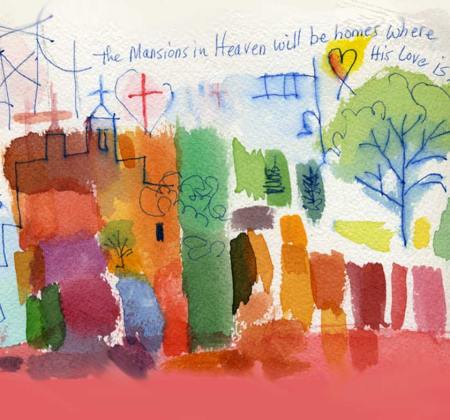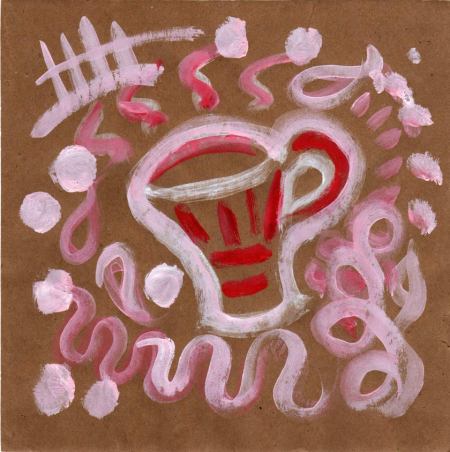Courage is not the absence of fear, but rather the judgment that something else is more important than fear. -Ambrose Redmoon
“We get lost in our daily life, and daily art. We don’t always like plans or structure or any kind of “system”. Then sometimes the lone artist encounters fears. Take heart, my dear friend artist. You are not alone. Read on.” -KGT
Recently I began making new art for a painting series scheduled to be exhibited in Denver May 1st. Lots of big white canvases are staring at me in and outside of my studio. There is always a moment of “GULP!” at the beginning of a painting. Trepidation.
I think painting might be a little like stand up comedy, from what I hear from the performers on shows like “Comedians in Cars, Getting Coffee” by Jerry Seinfeld and his comedy friends. (Great show, by the way.) Some comedians say they are incredibly nervous right before they walk out, some nearly every time they perform, even if they’ve been doing it for quite a while.
I use a few little ways to get past the fear of beginning a painting. My main media is acrylic paint, but most of this translates to watercolor on paper too, after suggestion #1. Here are some action tips, see what works for you:
1. Tone the canvas with a bit of color you will use in your future painting idea. (See # 5. Color Plan.) This gets you painting in a non-threatening way, and the big bad white of the canvas is now gone. I like a light red or orange, sometimes just a tint. Maybe yellow or blue. Stay away from browns, dark grays or black. Keep it light.
2. Turn on music. Get a cup of coffee or tea. Start painting after 5 minutes or so, making sure all your supplies are ready to go.
3. Pretend this is your job and you must work it today, for however long a session you have in mind. You might get fired if you don’t produce! ( I actually importantly learned I could work this way when I got my first illustrator/designer job back in the day. There was no waiting for the creative “feeling” to appear, we just had to get going!)
4. Warm-ups, warm-ups, warm-ups. Get a brush, a large cheap piece paper or two, and one or two colors of paint. Start making brush strokes on the page, any way you wish. Loopy loops, pouncing hits, drippy washes, just have some fun. Take as long as you wish. When I taught my painting classes, sometimes we would do warm-ups for as long as 20 minutes. You will not be painting on your new canvas stone cold now.
My writer daughter Anne reminded me that writers are encouraged to do warm-ups in the way of free writing. (This equates to the “Morning pages” I made while doing the Artist’s Way plan years ago. Julia Cameron book, check it out.) My musician brother and any singer or dancer will tell you this is just plain useful and what they do all the time. Why shouldn’t painters remember to do this too? Do you have your way of warming up, you painters out there? Please share.

Experimental watercolor palette, saved. A cropped part of this is now the image on my business card. Ha!
5. Make 2 plans. One is a little sketch for the composition idea. 3 x 4″ is fine, just something. I don’t work from elaborate drawings anymore, but I do like a sketch. The second plan is a color palette. Again, it doesn’t have to be elaborate, but creating by mixing a palette of 5 or 6 colors does get a person to feel more like jumping right in to paint. Don’t forget to place daubs of each color on a white page. Save this palette page for future reference.
6. Work in a size that is comfortable for you, especially if you have not painted for a while. No use scaring yourself silly with a giant canvas right at the git-go. It’s also better to work at a size that lets you make more paintings often. Don’t be a slave to a piece you can’t finish in a reasonable amount of time. For some that means finish in a week, for others it means finish in a day.
Buy a pad of canvas paper and make several smaller paintings with that. You can get 2 paintings out of a 16 x 20″ piece of canvas paper. I even do small color studies on 6 x 8″ pieces each. If you make a masterpiece painting on canvas paper you can always let the framer work their magic to be a gorgeous presentation piece.
7. Tell your inner self “This painting is not to be my masterpiece, but will get me to painting a really great painting someday.” Save this sentence. Repeat when you begin the next painting. And on and on. One day you will be painting great things and you won’t be worrying about starting new ones. You will love the process more, things will flow along, and don’t ever EVER forget the warm-ups. Great ideas are born out of free-wheeling play.
End of story. I am reminding myself of these ideas I shared with you today.
We get lost in our daily life, and daily art. We don’t always like plans or structure or any kind of “system”. Take heart, my dear friend artist. You are not alone. Read on.
I just realized I should put this small paragraph at the top of the post. So I am placing it there now! There are no formulas for making art, because it is a discovery process for each individual, unique person. There is only sharing our images and our experiences. So let’s share more. Send me your art jpegs, I’d love to see them or please share your words too.
God bless and keep you, dear artist.
love, karen
Tags: abstract painting, acrylic painting, art and fear, color palettes, comedians in cars getting coffee, courage, drawing what you like, inpiration for painters, mixing paints, painting techniques, warm and cool colors



February 19, 2015 at 3:02 am |
Dear JKaren, Thank you for this beautiful post!
LikeLike
February 19, 2015 at 3:06 am |
Thank you Martine! take care, -Karen
LikeLike
February 19, 2015 at 3:31 am |
Thank you. Many blessings on you, too. Today I had to overcome a regular roadblock. As a quilter, my palette is the fabric I have on hand. Occasionally that won’t do and I need to shop. But my first intention is always to use what’s here. As you know, that is limiting. I can’t continue to blend until magically I hit the right hue and value. But I’m pretty good, so usually I can make it work.
The roadblock is in imagination, difficulty visualizing what I have in the form I intend to use it. Will this grey be too cool and dull with that blue? Will the pale green be too light, since I am emphasizing black, too?
And I have learned to remind myself that if I make components that don’t end up working well, there is no disaster that happened. Today’s issue is with sewing stars. If I sew a bunch of star blocks and find they are unusable, that is only for this project. They almost always can be used some other way. No bad thing happened here. No bad thing happened here. No fabric was so precious that I couldn’t experiment, see if it would work. No bad thing happened here…
So I started cutting fabrics for my star blocks, and tomorrow I will sew them. I still can’t visualize them for their finish. They might not work. I’ve decided that’s okay. No bad thing will have happened either way.
LikeLike
February 19, 2015 at 3:59 am |
Melanie, thanks for your comment, you hit the nail on the head. We work with the materials at hand. Quilters have their fabric stash, painters their paints and how they can mix them to the best of their ability. Choosing a color palette is not easy for quilters, since you are limited to the fabrics at hand or the inspiration pictures you find to tell you to go out and find new fabrics to complete that dream palette. Painters and quilters can learn from each other, since we all love and pursue color. My quilting friend Sherri Driver at McCalls keeps all her blocks and eventually makes them into wonderful creations. I save my painted color palettes for the same reason. Keep your works, whatever stage that work is in. You can revisit it at a new day and presto! The resolution might come. I’ve had that happen.
I like your confidence, you have learned you are pretty good. I bet you are a little more than “pretty good.” 🙂
Sewing stars is a good thing.
love and care to you,
Karen
LikeLike
February 19, 2015 at 11:49 am |
Great article! I agree about getting something – anything – on that blank white scary canvas asap, then it is much easier.
Also, I like to start a painting session with a bit of a tidy up, laying out of tools, switching the radio on and by the time I have done that, I am ready to go!
LikeLike
February 19, 2015 at 2:26 pm |
Rolina I see you have your routine working well for you. How’s your work coming now that the 30 in 30 challenge is over? Thanks for commenting.
LikeLike
February 19, 2015 at 12:48 pm |
It’s great knowing your process!! I will be warming up in a just a couple of hours!
LikeLike
February 19, 2015 at 2:26 pm |
Grab your coffee, we will warm up together! Another art day here.
LikeLike
February 19, 2015 at 3:04 pm |
I’m working on two sketches for two paintings – acrylic on paper (water media) to enter in a juried show. Most of the time I do a lot of thinking about how I’m going to paint a painting, which colors I want to use, usually only 5 or 6 main colors mixing with white for lights and combining these colors for darker versions, where I will start, background, main focus.
The better I plan, the better my final painting turns out. I prep my paper/canvas, getting the sketch on and dive in with painting, usually working for a few hours. Using acrylic works for me because I can be impatient and it drys relatively quickly, which is why my planning is important.
I’m not afraid to dive in when I have my plan in my head. I’m getting better at it. The more you do it, the easier it is.
LikeLike
February 19, 2015 at 4:16 pm |
Right! The more you do it, the easier it is. Sounds like you have a good momentum going, and planning is working for you. Good luck with your juried show, rjkary.
LikeLike